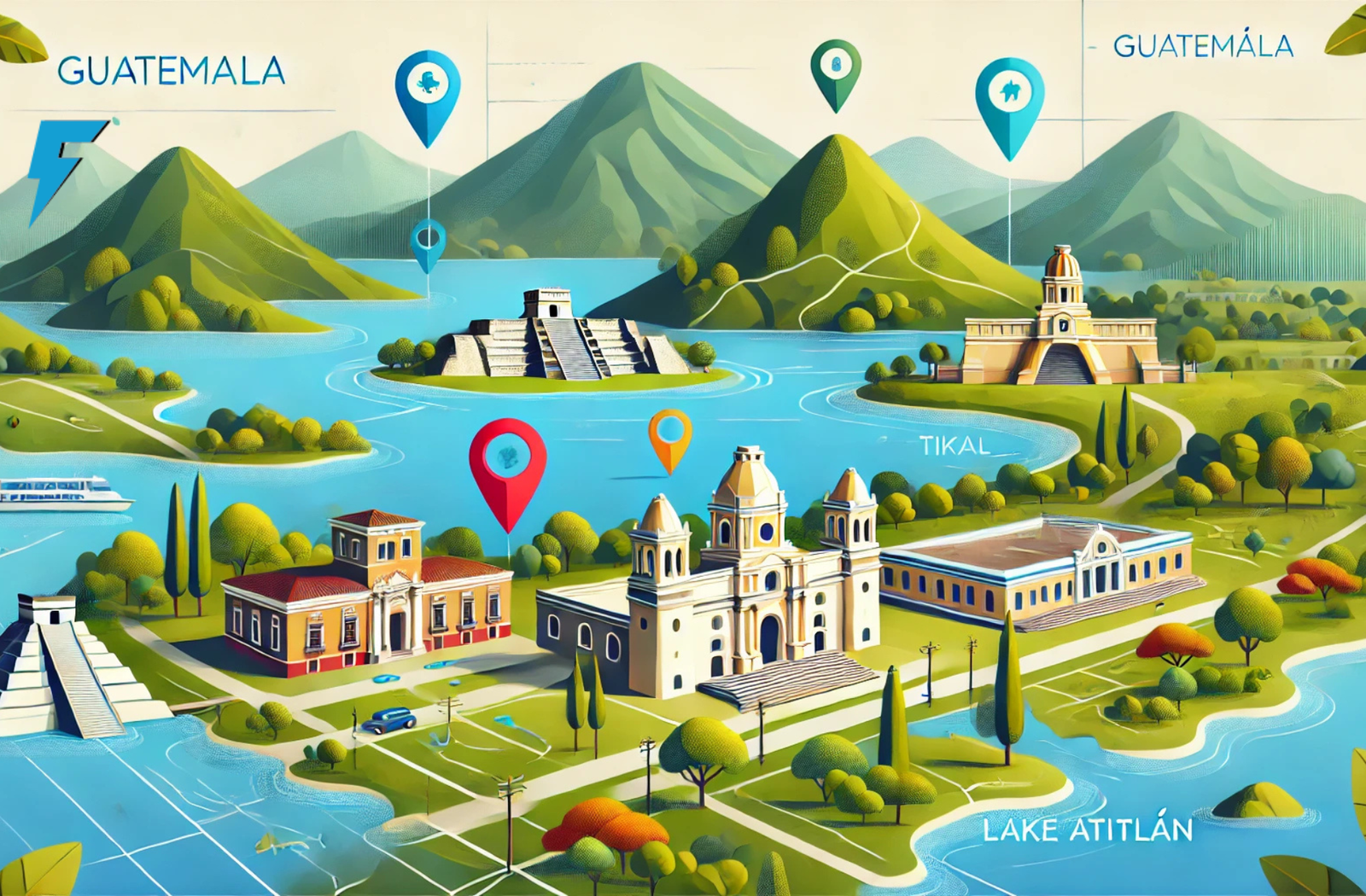Table of Contents
1. Introduction to Guatemala
( Map:te9vcjtdaa8= Guatemala )
Guatemala, a Central American nation, is known for its rich indigenous culture and history, a reflection of its Mayan heritage and Spanish colonial influence. Bordered by Mexico, Belize, Honduras, and El Salvador, it bridges the Pacific Ocean and the Caribbean Sea. As a nation marked by diverse ecosystems and vibrant culture, Guatemala offers a dynamic mix of history and natural beauty that captivates residents and visitors alike.
2. Historical Background
( Map:te9vcjtdaa8= Guatemala )
The history of Guatemala dates back thousands of years, with the rise of the Mayan civilization as one of the region’s most significant cultural milestones. The ancient Maya established great city-states such as Tikal and Copán, which became centers of trade, culture, and political influence. The Spanish conquest in the 16th century brought dramatic changes, reshaping the region’s cultural, social, and economic landscape.

3. Mayan Influence and Archaeological Sites
( Map:te9vcjtdaa8= Guatemala )
Guatemala boasts some of the world’s most significant Mayan archaeological sites. Tikal, located in northern Guatemala, is a UNESCO World Heritage site renowned for its towering pyramids and ancient temples. Sites like Quiriguá and El Mirador also stand as important vestiges of this great civilization, offering insights into Mayan life, rituals, and governance.
4. Colonial Era and Spanish Influence
( Map:te9vcjtdaa8= Guatemala )
Spanish rule left an indelible mark on Guatemala, influencing its architecture, religion, language, and culture. The former colonial capital, Antigua Guatemala, is a well-preserved city known for its cobblestone streets, Baroque buildings, and ornate churches. The Spanish introduced Christianity, leading to the fusion of indigenous beliefs and Catholicism that remains prominent today.
5. Independence and Nationhood
( Map:te9vcjtdaa8= Guatemala )
Guatemala gained independence from Spain on September 15, 1821, becoming part of the Federal Republic of Central America. However, political instability and conflicts eventually led to its declaration as a sovereign nation in 1847. Since independence, Guatemala has experienced periods of conflict and reform, shaping its modern political landscape.
6. Civil War and Peace Process
( Map:te9vcjtdaa8= Guatemala )
From 1960 to 1996, Guatemala endured a brutal civil war between government forces and leftist guerrilla groups, leading to widespread human rights abuses. The conflict disproportionately affected indigenous communities. The signing of the Peace Accords in 1996 marked the end of this era, paving the way for a more inclusive democracy and transitional justice initiatives.
7. Demographics and Ethnic Diversity
( Map:te9vcjtdaa8= Guatemala )
Guatemala’s population is incredibly diverse, consisting of a mix of indigenous peoples, mestizos (Ladinos), and other ethnic groups. Indigenous groups, primarily of Mayan descent, make up a significant portion of the population and speak a variety of Mayan languages alongside Spanish, the official language.
8. Languages of Guatemala
( Map:te9vcjtdaa8= Guatemala )
Spanish is the dominant language in Guatemala; however, 21 Mayan languages, as well as Garifuna and Xinca, are spoken throughout the country. The linguistic diversity reflects the country’s rich cultural mosaic. Efforts have been made to preserve these indigenous languages, especially within educational and cultural contexts.
9. Culture and Traditions
( Map:te9vcjtdaa8= Guatemala )
Guatemalan culture is a vibrant fusion of indigenous and Spanish influences. Traditional Mayan rituals coexist with Catholic practices, and cultural celebrations are characterized by colorful textiles, music, dance, and elaborate ceremonies. Semana Santa (Holy Week) in Antigua is one of the most important religious events in the country.

10. Cuisine of Guatemala
( Map:te9vcjtdaa8= Guatemala )
Guatemalan cuisine blends indigenous and Spanish influences, with dishes like pepian, a spicy stew, and tamales being staples. Corn, beans, rice, and a variety of herbs and spices form the basis of many meals. Coffee and cocoa are also central to Guatemalan gastronomy, with coffee being a key export product.
11. Geography and Topography
( Map:te9vcjtdaa8= Guatemala )
Guatemala’s diverse geography ranges from volcanic highlands to lush rainforests and expansive coastlines. The country is home to more than 30 volcanoes, with some like Pacaya and Fuego remaining active. The central highlands contain rugged mountains, while the northern Petén region boasts tropical forests. This varied landscape supports a rich biodiversity and influences the local climate.
12. Climate and Seasons
( Map:te9vcjtdaa8= Guatemala )
The climate in Guatemala varies by altitude, creating several microclimates across the country. In general, there are two main seasons: the dry season, known as Verano, typically lasting from November to April, and the wet season, or invierno, from May to October. Lowland areas are hot and humid, while the highlands experience a cooler and more temperate climate.
13. Biodiversity and National Parks
( Map:te9vcjtdaa8= Guatemala )
Guatemala is recognized for its rich biodiversity, with numerous national parks and protected areas. The Maya Biosphere Reserve in Petén is a vast rainforest region home to many rare and endangered species, such as jaguars and scarlet macaws. Conservation efforts continue to play a crucial role in preserving the country’s unique ecosystems and wildlife.
14. Economy and Major Industries
( Map:te9vcjtdaa8= Guatemala )
Guatemala’s economy is one of the largest in Central America, driven primarily by agriculture, manufacturing, and services. Key exports include coffee, bananas, sugar, textiles, and vegetables. Despite economic growth, challenges such as income inequality and poverty persist. Efforts are being made to improve education, infrastructure, and economic inclusivity.
15. Agriculture and Coffee Production
( Map:te9vcjtdaa8= Guatemala )
Agriculture remains a cornerstone of Guatemala’s economy, with coffee being a vital export product. Coffee plantations, often found in the highlands, produce some of the finest Arabica beans, prized worldwide for their quality and flavor. Other significant crops include bananas, sugarcane, maize, and beans, employing a substantial portion of the population.
16. Urbanization and Major Cities
( Map:te9vcjtdaa8= Guatemala )
Guatemala City, the capital, is the largest and most populous city, serving as the country’s political, economic, and cultural hub. Other key cities include Quetzaltenango (also known as Xela), a center of indigenous culture, and Antigua Guatemala, famous for its colonial charm. Urbanization presents both opportunities and challenges, particularly in housing, infrastructure, and public services.
17. Education System in Guatemala
( Map:te9vcjtdaa8= Guatemala )
Education in Guatemala faces challenges such as low enrollment rates, limited access to resources, and a rural-urban divide. While primary education is compulsory, many children, particularly from indigenous communities, struggle to complete schooling due to economic hardships. Efforts by the government and non-profits aim to improve literacy and access to education.
18. Health Care and Social Services
( Map:te9vcjtdaa8= Guatemala )
The Guatemalan healthcare system consists of public and private sectors, but access to quality care remains a significant challenge for many. Rural and indigenous populations often face limited healthcare resources and disparities. Health issues such as malnutrition, maternal mortality, and infectious diseases are prevalent, prompting ongoing efforts to strengthen healthcare delivery.
19. Tourism Industry and Attractions
( Map:te9vcjtdaa8= Guatemala )
Tourism is a growing sector in Guatemala, with visitors drawn to its cultural heritage, natural beauty, and archaeological sites. From exploring the ancient ruins of Tikal to hiking the volcanoes near Lake Atitlán, there is no shortage of activities for travelers. Ecotourism and cultural tourism offer unique experiences, promoting sustainable development and local economies.

20. Lake Atitlán: A Natural Wonder
( Map:te9vcjtdaa8= Guatemala )
Lake Atitlán, surrounded by volcanoes and traditional Mayan villages, is one of Guatemala’s most iconic destinations. The lake, renowned for its stunning beauty and tranquility, offers opportunities for kayaking, hiking, and exploring indigenous cultures. Each village around the lake has its unique traditions, languages, and crafts, attracting tourists and anthropologists alike.
21. Guatemalan Textiles and Handicrafts
Guatemala is famous for its vibrant textiles, woven by indigenous women using traditional techniques passed down through generations. Each community has distinct patterns and colors representing its cultural heritage. Markets such as Chichicastenango are bustling with artisans selling textiles, ceramics, and jewelry, showcasing Guatemala’s artistic heritage.
22. Traditional Music and Dance
Guatemalan music reflects its diverse cultural roots, blending Mayan, Spanish, and Afro-Caribbean influences. Traditional instruments like the marimba hold a special place, and folk dances often accompany religious or cultural celebrations. From the solemn Baile de la Conquista to festive displays, music, and dance are integral aspects of the country’s identity.
23. Religion and Spiritual Practices
Religion in Guatemala is a blend of Catholicism, Evangelical Protestantism, and indigenous beliefs. Many indigenous communities practice syncretic faiths, merging Catholic rituals with Mayan traditions. This spiritual diversity is evident in ceremonies, festivals, and sacred sites, where ancient practices and modern beliefs coexist harmoniously.
24. Political Structure and Government
Guatemala is a democratic republic, with a president serving as the head of state and government. The political landscape has seen significant shifts since the signing of the Peace Accords in 1996. Despite progress, the country grapples with corruption, political polarization, and efforts to strengthen the rule of law and democratic institutions.

25. Challenges and the Road Ahead
Guatemala faces various challenges, from poverty and inequality to climate change and political corruption. Social and economic reforms, investment in education, and climate resilience are priorities for sustainable development. Despite these obstacles, the resilience, cultural richness, and diverse heritage of the Guatemalan people remain sources of strength and hope for a brighter future.
Conclusion
Guatemala is a land of endless discovery, and( Map:te9vcjtdaa8= Guatemala ) serves as a modern companion for travelers. From cultural landmarks to natural wonders, let this tool guide you through a memorable adventure.
Also read…( Photography:UWN7OZFJ-RW= Emma Watson )





